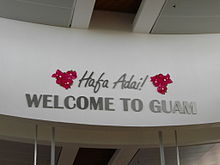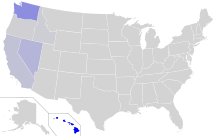- Chamorro language
-
Chamorro Fino'Chamorro Spoken in  Guam
Guam
 Northern Mariana Islands
Northern Mariana IslandsRegion Western Pacific Ocean Ethnicity Chamorro people Native speakers First language: more than 60,000 (date missing) Language family Austronesian- Malayo-Polynesian (MP)
- Nuclear MP
- Sunda–Sulawesi MP ?
- Chamorro
- Sunda–Sulawesi MP ?
- Nuclear MP
Official status Regulated by No official regulation Language codes ISO 639-1 ch ISO 639-2 cha ISO 639-3 cha This page contains IPA phonetic symbols in Unicode. Without proper rendering support, you may see question marks, boxes, or other symbols instead of Unicode characters. Chamorro (Chamorro: Fino' Chamoru or simply Chamoru) is a Malayo-Polynesian (Austronesian) language, spoken on the Mariana Islands (Guam, Rota, Tinian, and Saipan) by about 47,000 people (about 35,000 people on Guam and about 12,000 in the N. Marianas).[1]
Contents
Speakers
The numbers of Chamorro speakers have declined in recent years, and the younger generations are less likely to know the language. The influence of English has caused the language to become endangered. On Guam (called "Guåhan" by Chamorro speakers, from the word guaha, meaning "have", but its English meaning is, "We Have", from the idea that they had everything they needed,[2][3]) the number of native Chamorro speakers has dwindled in the last decade or so, while in the Northern Mariana Islands, young Chamorros still speak the language fluently. Various representatives from Guam have unsuccessfully lobbied the United States to take action to promote and protect the language.[citation needed]
It is still common among Chamorro households in the Northern Marianas, but fluency has greatly decreased among Guamanian Chamorros during the years of American rule in favor of American English, which is commonplace throughout the inhabited Marianas.
Classification
Unlike most of its neighbors, Chamorro is not a Micronesian or Polynesian language. Rather, like Palauan, it constitutes a possibly independent branch of the Malayo-Polynesian language family. Its indigenous origins are thus somewhat obscure. A 2008 analysis of the Austronesian Basic Vocabulary Database[4] suggested an 85% confidence level that it is closest to the Central–Eastern Malayo-Polynesian languages.
Chamorro also has much Spanish influence, due to three centuries of Spanish colonial rule. Many Chamorro nouns, adjectives, prepositions, numerals, and verbs are of Spanish origin. Under a historical point of view, it may be considered a mixed language, even if it is now independent and unique.[5] When Guam was colonised by the United States, Chamorro was at the pre-stage of being transformed into a Spanish-based creole, and the transfer of rule made it so that it never reached that point.[citation needed]
Orthography
Letter pronunciation ’ [ʔ] (glottal stop) A [æ] Å [ɑ] B [b] Ch [ts] D [d] E [e] F [f] G [ɡ] Gu [ɡʷ] H [h] I [i] K [k] L [l] M [m] N [n] Ñ [ɲ] Ng [ŋ] O [o] P [p] R [ɾ] S [s] T [t] U [u] Y [dz] Note that the letter Y is pronounced more like 'dz' (an approximation of the regional Spanish pronunciation of "Y"/"LL" as [dʒ]); nor are N and Ñ always distinguished. Thus the Guamanian place name spelled Yona is pronounced 'dzo-nia' [dzo.ɲa], not 'yo-na' [jo.na] as might be expected. Note also that Ch is usually pronounced like 'ts' rather than 'tsh' and that A and Å are not always distinguished in written Chamorro (often being written simply as 'A'). R in Chamorro is pronounced like [ɾ] like Spanish in between vowels; and as a retroflex approximant at the beginning of words [ɻ].
Chamorro has geminate consonants which are written double (GG, DD, KK, MM, NGNG, PP, SS, TT), native diphthongs AI and AO, plus OI, OE, IA, IU, IE in loanwords; penultimate stress, except where marked otherwise with an acute accent, as in asút "blue" or dángkulo "big". Unstressed vowels are limited to /ə i u/, though they are often spelled A E O. Syllables may be consonant-vowel-consonant, as in che’lu "sibling", diskatga "unload", mamahlao "shy", or oppop "lie face down", gatus (old word for 100), Hagåtña (Capital of Guam); B, D, and G are not distinguished from P, T, and K in that position[vague].
Chamorro grammar
Chamorro is an agglutinative language, grammatically allowing root words to be modified by a number of affixes. For example, masanganenñaihon "talked awhile (with/to)", passive marking prefix ma-, root verb sangan, referential suffix i "to" (forced morphophonemically to change to e) with excrescent consonant n, and suffix ñaihon "a short amount of time". Thus Masanganenñaihon gue' "He/she was told (something) for a while".
Chamorro has many Spanish loanwords and other words have Spanish etymological roots (e.g. tenda "shop/store" from Spanish tienda), which may lead some to mistakenly conclude that the language is a Spanish Creole: Chamorro very much uses its loan words in a Micronesian way (e.g.: bumobola "playing ball" from bola "ball, play ball" with verbalizing infix -um- and reduplication of first syllable of root).
Chamorro is predicate-initial, head-marking language. It has a rich agreement system both in the nominal and in the verbal domains. The following table gives the possessor-noun agreement suffixes:[6]
Person/Number Suffix 1 sg -hu / -ku 2 sg -mu 3 sg -ña 1 incl du/pl -ta 1 excl du/pl -(n)mami 2 du/pl -(n)miyu 3 du/pl -(n)ñiha Chamorro is also known for its wh-agreement in the verb: these agreement morphemes agree with features (roughly, the Grammatical case feature) of the question phrase, and replace the regular subject–verb agreement:[7]
(1) Ha-fa'gasi si Juan i kareta. 3sSA[8]-wash PND[9] Juan the car 'Juan washed the car.'
(2) Hayi fuma'gasi i kareta? who? WH[nom].[10] wash the car 'Who washed the car?'
Chamorro basic phrases
Håfa Adai Hello. [informal] Memorias [Spanish introduced] Greetings Kao mamaolek ha' hao? How are you? [lit.: Are you doing well?][informal] Håfa tatatmånu hao? How are you?[formal] Håyi nå'ån-mu? What is your name? Nå'ån-hu si Chris My name is Chris. Ñålang yo' I'm hungry. Må'o yo' I'm thirsty. Ådios [Spanish introduced] Good bye. Put Fabot [Spanish introduced] please Fanatåtte[Indigenous] Good bye (lit.: And so you will follow.) Buenas dias [Spanish introduced] Good morning. Buenas tåtdes [Spanish introduced] Good afternoon. Buenas noches [Spanish introduced] Good night. Esta ågupa' Until tomorrow Si Yu'us ma'åse' Thank you (lit: God have mercy) Buen probecho [Spanish introduced] "You're Welcome" Numbers
Current common Chamorro uses only number words of Spanish origin: unu, dos, tres, etc. Old Chamorro used different number words based on categories: "Basic numbers" (for date, time, etc.), "living things", "inanimate things", and "long objects".
English Modern Chamorro Old Chamorro: Basic Numbers Old Chamorro: Living Things Old Chamorro: Inanimate Things Old Chamorro: Long Objects one unu/una (time) hacha maisa hachiyai takhachun two dos hugua hugua hugiyai takhuguan three tres tulu tato to'giyai taktulun four kuåttro' fatfat fatfat fatfatai takfatun five singko' lima lalima limiyai takliman six sais gunum guagunum gonmiyai ta'gunum seven sietti fiti fafiti fitgiyai takfitun eight ocho' gualu guagualu guatgiyai ta'gualun nine nuebi sigua sasigua sigiyai taksiguan ten dies manot maonot manutai takmaonton hundred siento gatus gatus gatus gatus/manapo - The number 10 and its multiples up to 90 are: dies(10), benti(20), trenta(30), kuårenta(40), sinkuenta(50), sisenta(60), sitenta(70), ochenta(80), nubenta(90)
- Similar to Spanish terms: diez(10), veinte(20), treinta(30), cuarenta(40), cincuenta(50), sesenta(60), setenta(70), ochenta(80), noventa(90).
Chamorro Studies
Chamorro language is studied at the University of Guam and in several academic institutions of Guam and the Northern Marianas.
Researches in several countries are also studying different aspects of Chamorro. In 2009, the Chamorro Linguistics International Network (CHIN) [1] was established in Bremen, Germany. CHiN was founded on occasion of the Chamorro Day (27 September 2009) which was part of the programme of the Festival of Languages [2]. The foundation ceremony was attended by people from Germany, Guam, the Netherlands, New Zealand, Spain, Switzerland, and the United States of America. [11]
See also
Notes
- ^ Chung, Sandra. 1998. The design of agreement: Evidence from Chamorro. University of Chicago Press: Chicago.
- ^ Tamondong, Dionesis (2010-02-16). "Camacho: Name change will affirm identity". Pacific Daily News. http://www.guampdn.com/article/20100216/NEWS01/2160308/1002/Camacho-Name-change-will-affirm-identity. Retrieved 2010-02-18.[dead link]
- ^ José Antonio Saco. Colección de papeles científicos, históricos, políticos y de otros ramos sobre la isla de Cuba. 1859.
- ^ Austronesian Basic Vocabulary Database
- ^ Rafael Rodríguez-Ponga, Del español al chamorro: Lenguas en contacto en el Pacífico. Madrid, Ediciones Gondo, 2009, www.edicionesgondo.com
- ^ Chung 1998:49
- ^ Chung 1998:236 and passim
- ^ '3sSA' stands for 3rd singular Subject Agreement.
- ^ 'PND' stands for Proper Noun Determiner, a special article used with names in Chamorro.
- ^ The '-um-' in 'fumagasi' is an infix, glossed as WH[nom], meaning that it is a WH-agreement morpheme for nominative question phrases.
- ^ The Maga’låhi (president) is Dr. Rafael Rodríguez-Ponga Salamanca (Madrid, Spain); Maga’låhi ni onrao (honorary president): Dr. Robert A. Underwood (President, University of Guam); Teniente maga’låhi (vice-president): Prof. Dr. Thomas Stolz (Universität Bremen).
General references
- Aguon, K. B. (1995). Chamorro: a complete course of study. Agana, Guam: K.B. Aguon.
- Chung, Sandra. 1998. The design of agreement: Evidence from Chamorro. University of Chicago Press: Chicago.
- Rodríguez-Ponga, Rafael (2003). El elemento español en la lengua chamorra. Madrid: Servicio de Publicaciones, Universidad Complutense (Complutense University of Madrid). http://eprints.ucm.es/3664/
- Topping, Donald M. (1973). Chamorro reference grammar. Honolulu: University of Hawaii Press.
- Topping, Donald M., Pedro M. Ogo, and Bernadita C. Dungca (1975). Chamorro-English dictionary. Honolulu: University of Hawaii Press.
- Topping, Donald M. (1980). Spoken Chamorro: with grammatical notes and glossary, rev. ed. Honolulu: University of Hawaii Press.
- Hunt, Mike (2008). "Speaking Chamoru Moru Moru". San Roque, Saipan.
External links
- Chamorro language at Ethnologue
- Chamorro-English Online Dictionary
- http://ns.gov.gu/language.html
- http://www.offisland.com/thelanguage.html
- http://www.chamorro.com/fino/fino.html
- Chamorro-English dictionary, partially available at Google Books.
- A Chamorro Reference Grammar, partially available at Google Books.
- http://www.websters-online-dictionary.org/definition/Chamorro-english/
- Chamorro Wordlist at the Austronesian Basic Vocabulary Database
- http://www.sous-le-soleil-de-guam.com
- http://www.fb10.uni-bremen.de/chin/ Chamorro Linguistics International Network (CHIN).
Languages of Oceania Sovereign states - Australia
- East Timor (Timor-Leste)
- Fiji
- Indonesia
- Kiribati
- Marshall Islands
- Federated States of Micronesia
- Nauru
- New Zealand
- Palau
- Papua New Guinea
- Samoa
- Solomon Islands
- Tonga
- Tuvalu
- Vanuatu
Dependencies and
other territories- American Samoa
- Christmas Island
- Cocos (Keeling) Islands
- Cook Islands
- Easter Island
- French Polynesia
- Guam
- Hawaii
- New Caledonia
- Niue
- Norfolk Island
- Northern Mariana Islands
- Pitcairn Islands
- Tokelau
- Wallis and Futuna
Categories:- Language articles with undated speaker data
- Agglutinative languages
- Languages of the Mariana Islands
- Malayo-Polynesian languages
- Languages of Guam
- Chamorro
- VSO languages
- Malayo-Polynesian (MP)
Wikimedia Foundation. 2010.


